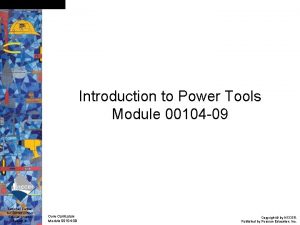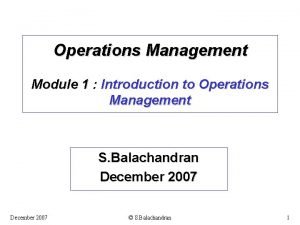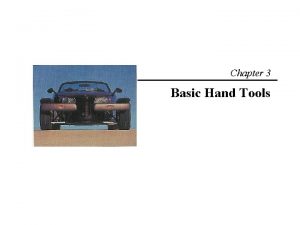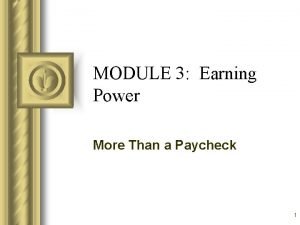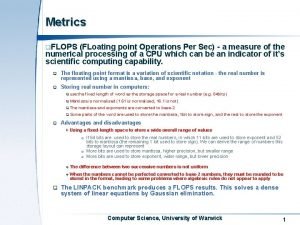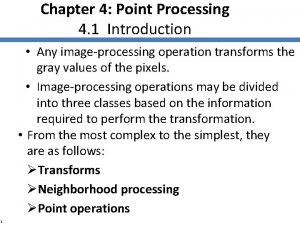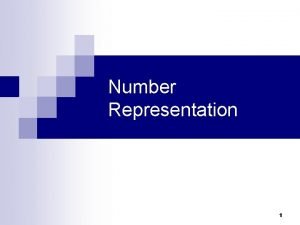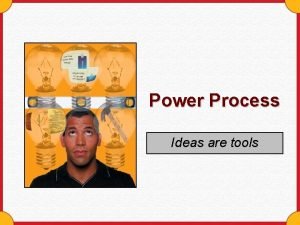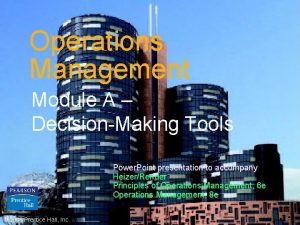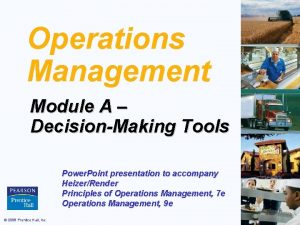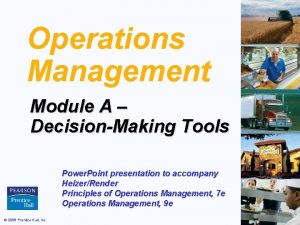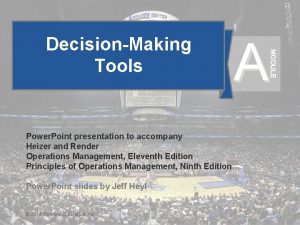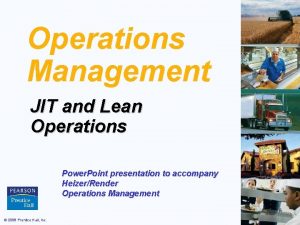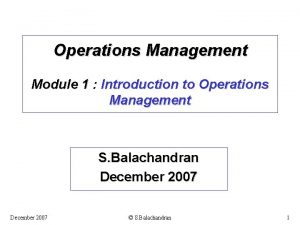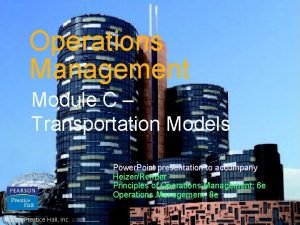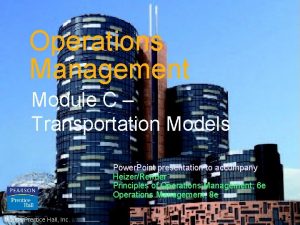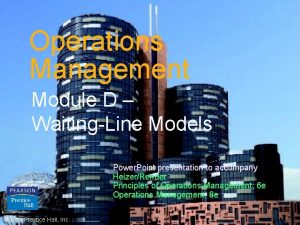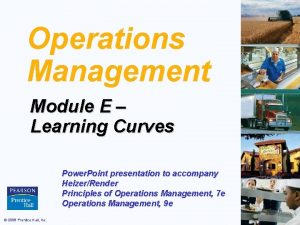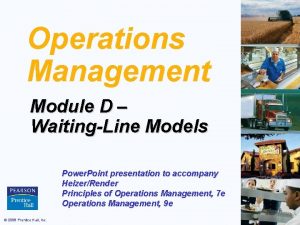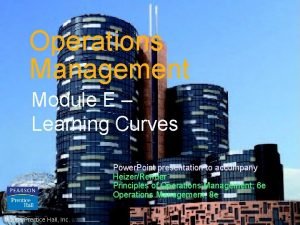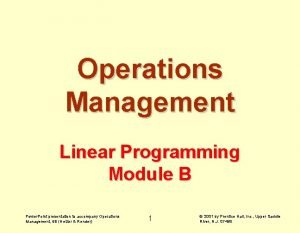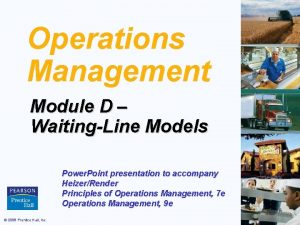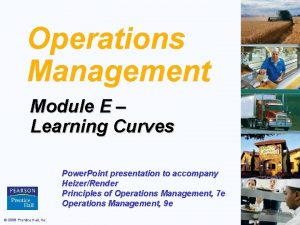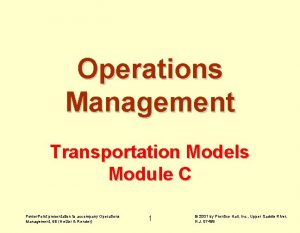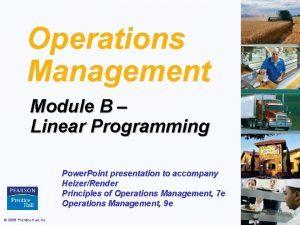Operations Management DecisionMaking Tools Module A Power Point































- Slides: 31

Operations Management Decision-Making Tools Module A Power. Point presentation to accompany Operations Management, 6 E (Heizer & Render) 1 © 2001 by Prentice Hall, Inc. , Upper Saddle River, N. J. 07458

Outline ¨ The Decision Process in Operations ¨ Fundamentals of Decision Making ¨ Decision Tables ¨ Decision Making under Uncertainty ¨ Decision Making Under Risk ¨ Decision Making under Certainty ¨ Expected Value of Perfect Information (EVPI) ¨ Decision Trees ¨A More Complex Decision Tree Power. Point presentation to accompany Operations Management, 6 E (Heizer & Render) 2 © 2001 by Prentice Hall, Inc. , Upper Saddle River, N. J. 07458

Learning Objectives When you complete this chapter, you should be able to : ¨ Identify or Define: Decision trees and decision tables ¨ Highest monetary value ¨ Expected value of perfect information ¨ Sequential decisions ¨ ¨ Describe or Explain: ¨ Decision making under risk Power. Point presentation to accompany Operations Management, 6 E (Heizer & Render) 3 © 2001 by Prentice Hall, Inc. , Upper Saddle River, N. J. 07458

Models, and the Techniques of Scientific Management ¨ Can Help Managers To: To Gain deeper insight into the nature of business relationships ¨ Find better ways to assess values in such relationships; and ¨ See a way of reducing, or at least understanding, uncertainty that surrounds business plans and actions ¨ Power. Point presentation to accompany Operations Management, 6 E (Heizer & Render) 4 © 2001 by Prentice Hall, Inc. , Upper Saddle River, N. J. 07458

Steps to Good Decisions ¨ Define problem and influencing factors ¨ Establish decision criteria ¨ Select decision-making tool (model) ¨ Identify and evaluate alternatives using decision-making tool (model) ¨ Select best alternative ¨ Implement decision ¨ Evaluate the outcome Power. Point presentation to accompany Operations Management, 6 E (Heizer & Render) 5 © 2001 by Prentice Hall, Inc. , Upper Saddle River, N. J. 07458

Models ¨ Are less expensive and disruptive than experimenting with the real world system ¨ Allow operations managers to ask “What if” types of questions ¨ Are built for management problems and encourage management input ¨ Force a consistent and systematic approach to the analysis of problems ¨ Require managers to be specific about constraints and goals relating to a problem ¨ Help reduce the time needed in decision making 6 Power. Point presentation to accompany Operations Management, 6 E (Heizer & Render) © 2001 by Prentice Hall, Inc. , Upper Saddle River, N. J. 07458

Limitations of Models They ¨ may be expensive and time-consuming to develop and test ¨ are often misused and misunderstood (and feared) because of their mathematical and logical complexity ¨ tend to downplay the role and value of nonquantifiable information ¨ often have assumptions that oversimplify the variables of the real world Power. Point presentation to accompany Operations Management, 6 E (Heizer & Render) 7 © 2001 by Prentice Hall, Inc. , Upper Saddle River, N. J. 07458

The Decision-Making Process Quantitative Analysis Problem Logic Historical Data Marketing Research Scientific Analysis Modeling Decision Qualitative Analysis Emotions Intuition Personal Experience and Motivation Rumors Power. Point presentation to accompany Operations Management, 6 E (Heizer & Render) 8 © 2001 by Prentice Hall, Inc. , Upper Saddle River, N. J. 07458

Ways of Displaying a Decision Problem ¨ Decision trees ¨ Decision tables Outcomes States of Nature Alternatives Decision Problem Power. Point presentation to accompany Operations Management, 6 E (Heizer & Render) 9 © 2001 by Prentice Hall, Inc. , Upper Saddle River, N. J. 07458

Fundamentals of Decision Theory The three types of decision models: ¨ Decision making under uncertainty ¨ Decision making under risk ¨ Decision making under certainty Power. Point presentation to accompany Operations Management, 6 E (Heizer & Render) 10 © 2001 by Prentice Hall, Inc. , Upper Saddle River, N. J. 07458

Terms: Fundamentals of Decision Theory continued ¨ Alternative: course of action or choice ¨ State of nature: an occurrence over which the decision maker has no control Symbols used in decision tree: o A decision node from which one of several alternatives may be selected ¡ A state of nature node out of which one state of nature will occur Power. Point presentation to accompany Operations Management, 6 E (Heizer & Render) 11 © 2001 by Prentice Hall, Inc. , Upper Saddle River, N. J. 07458

Decision Table States of Nature Alternatives State 1 State 2 Alternative 1 Outcome 2 Alternative 2 Outcome 3 Outcome 4 Power. Point presentation to accompany Operations Management, 6 E (Heizer & Render) 12 © 2001 by Prentice Hall, Inc. , Upper Saddle River, N. J. 07458

Decision Making Under Uncertainty ¨ Maximax - Choose the alternative that maximizes the maximum outcome for every alternative (Optimistic criterion) ¨ Maximin - Choose the alternative that maximizes the minimum outcome for every alternative (Pessimistic criterion) ¨ Equally likely - chose the alternative 13 with the highest average outcome. Power. Point presentation to accompany Operations Management, 6 E (Heizer & Render) © 2001 by Prentice Hall, Inc. , Upper Saddle River, N. J. 07458

Example - Decision Making Under Uncertainty Maxima x Power. Point presentation to accompany Operations Management, 6 E (Heizer & Render) 14 Maximin Equally likely © 2001 by Prentice Hall, Inc. , Upper Saddle River, N. J. 07458

Decision Making Under Risk ¨ Probabilistic decision situation ¨ States of nature have probabilities of occurrence ¨ Select alternative with largest expected monetary value (EMV) ¨ EMV = Average return for alternative if decision were repeated many times Power. Point presentation to accompany Operations Management, 6 E (Heizer & Render) 15 © 2001 by Prentice Hall, Inc. , Upper Saddle River, N. J. 07458

Expected Monetary Value Equation N Number of states of nature Value of Payoff EMV ( Ai ) = Vi *P(Vi ) Probability of payoff i =1 = V 1 *P(V 1 ) + V 2 * P(V 2 )+. . . +VN * P(VN ) Alternative i Power. Point presentation to accompany Operations Management, 6 E (Heizer & Render) 16 © 2001 by Prentice Hall, Inc. , Upper Saddle River, N. J. 07458

Example - Decision Making Under Uncertainty Best choice Power. Point presentation to accompany Operations Management, 6 E (Heizer & Render) 17 © 2001 by Prentice Hall, Inc. , Upper Saddle River, N. J. 07458

Expected Value of Perfect Information (EVPI ) ( ¨ EVPI places an upper bound on what one would pay for additional information ¨ EVPI is the expected value with perfect information minus the maximum EMV Power. Point presentation to accompany Operations Management, 6 E (Heizer & Render) 18 © 2001 by Prentice Hall, Inc. , Upper Saddle River, N. J. 07458

Expected Value With Perfect Information (EV|PI ) ( n EV| PI = å (Best outcome for the state of j =1 nature j) * P(Sj ) where j=1 to the number of states of nature, n Power. Point presentation to accompany Operations Management, 6 E (Heizer & Render) 19 © 2001 by Prentice Hall, Inc. , Upper Saddle River, N. J. 07458

Expected Value of Perfect Information ¨ EVPI = EV|PI - maximum EMV Power. Point presentation to accompany Operations Management, 6 E (Heizer & Render) 20 © 2001 by Prentice Hall, Inc. , Upper Saddle River, N. J. 07458

Expected Value of Perfect Information Favorable Unfavorabl Market ($)e Market ($) Construct a large plant Construct a small plant Do nothing 200, 000 $100, 0 00 $0 0. 50 Power. Point presentation to accompany Operations Management, 6 E (Heizer & Render) 21 EMV -$180, 000 $20, 00 0 $0 $40, 000 $0 0. 50 © 2001 by Prentice Hall, Inc. , Upper Saddle River, N. J. 07458

Expected Value of Perfect Information EVPI = expected value with perfect information - max(EMV) EMV = $200, 000*0. 50 + 0*0. 50 $40, 000 = $60, 000 Power. Point presentation to accompany Operations Management, 6 E (Heizer & Render) 22 © 2001 by Prentice Hall, Inc. , Upper Saddle River, N. J. 07458

Expected Opportunity Loss ¨ EOL is the cost of not picking the best solution ¨ EOL = Expected Regret Power. Point presentation to accompany Operations Management, 6 E (Heizer & Render) 23 © 2001 by Prentice Hall, Inc. , Upper Saddle River, N. J. 07458

Computing EOL - The Opportunity Loss Table Power. Point presentation to accompany Operations Management, 6 E (Heizer & Render) 24 © 2001 by Prentice Hall, Inc. , Upper Saddle River, N. J. 07458

The Opportunity Loss Table continued Power. Point presentation to accompany Operations Management, 6 E (Heizer & Render) 25 © 2001 by Prentice Hall, Inc. , Upper Saddle River, N. J. 07458

The Opportunity Loss Table continued Power. Point presentation to accompany Operations Management, 6 E (Heizer & Render) 26 © 2001 by Prentice Hall, Inc. , Upper Saddle River, N. J. 07458

Sensitivity Analysis EMV(Large Plant) = $200, 000 P - (1 P)$180, 000 EMV(Small Plant) = $100, 000 P - $20, 000(1 P) EMV(Do Nothing) = $0 P + 0(1 -P) 1 -P Power. Point presentation to accompany Operations Management, 6 E (Heizer & Render) 27 © 2001 by Prentice Hall, Inc. , Upper Saddle River, N. J. 07458

Sensitivity Analysis continued ) EMV nt a l P l l Sma ( t) n la P e arg L ( V EM Power. Point presentation to accompany Operations Management, 6 E (Heizer & Render) 28 © 2001 by Prentice Hall, Inc. , Upper Saddle River, N. J. 07458

Decision Trees ¨ Graphical display of decision process ¨ Used for solving problems With 1 set of alternatives and states of nature, decision tables can be used also ¨ With several sets of alternatives and states of nature (sequential decisions), decision tables cannot be used ¨ ¨ EMV is criterion most often used Power. Point presentation to accompany Operations Management, 6 E (Heizer & Render) 29 © 2001 by Prentice Hall, Inc. , Upper Saddle River, N. J. 07458

Analyzing Problems with Decision Trees ¨ Define the problem ¨ Structure or draw the decision tree ¨ Assign probabilities to the states of nature ¨ Estimate payoffs for each possible combination of alternatives and states of nature ¨ Solve the problem by computing expected monetary values for each 30 state-of-nature node Power. Point presentation to accompany Operations Management, 6 E (Heizer & Render) © 2001 by Prentice Hall, Inc. , Upper Saddle River, N. J. 07458

Decision Tree State 1 1 e v ati rn e t Al Alt ern ativ e 2 1 State 2 State 1 2 Decision Node Power. Point presentation to accompany Operations Management, 6 E (Heizer & Render) State 2 Outcome 1 Outcome 2 Outcome 3 Outcome 4 State of Nature Node 31 © 2001 by Prentice Hall, Inc. , Upper Saddle River, N. J. 07458
 Survey of household economics and decisionmaking
Survey of household economics and decisionmaking Module 00104-15 introduction to power tools answer key
Module 00104-15 introduction to power tools answer key 00104 power tools
00104 power tools Operation management module
Operation management module Power triangle formula
Power triangle formula Power bi training powerpoint
Power bi training powerpoint Point point power
Point point power C device module module 1
C device module module 1 Quality management in operations management
Quality management in operations management Chapter 12 inventory management
Chapter 12 inventory management Operations management with total quality management book
Operations management with total quality management book Module 00103 introduction to hand tools
Module 00103 introduction to hand tools Module 3 introduction to hand tools test
Module 3 introduction to hand tools test Basic hand tools test answers
Basic hand tools test answers Module 3 exam introduction to hand tools answers
Module 3 exam introduction to hand tools answers Nccer introduction to hand tools
Nccer introduction to hand tools The power of laughter module c
The power of laughter module c Module 3 earning power
Module 3 earning power The appropriate cutting tool used in cutting fabrics
The appropriate cutting tool used in cutting fabrics Floating point operations per second
Floating point operations per second Point processing in digital image processing
Point processing in digital image processing Point processing operations
Point processing operations Floating point
Floating point Point processing and neighbourhood processing
Point processing and neighbourhood processing Fixed power driven woodworking tools
Fixed power driven woodworking tools The power process ideas are tools
The power process ideas are tools Hand tool quiz
Hand tool quiz Pneumatic tool safety osha
Pneumatic tool safety osha Osha hand and power tool safety
Osha hand and power tool safety Power tools safety training ppt
Power tools safety training ppt Chapter 10 power tools and shop equipment
Chapter 10 power tools and shop equipment Power tools must be fitted with guards and
Power tools must be fitted with guards and

